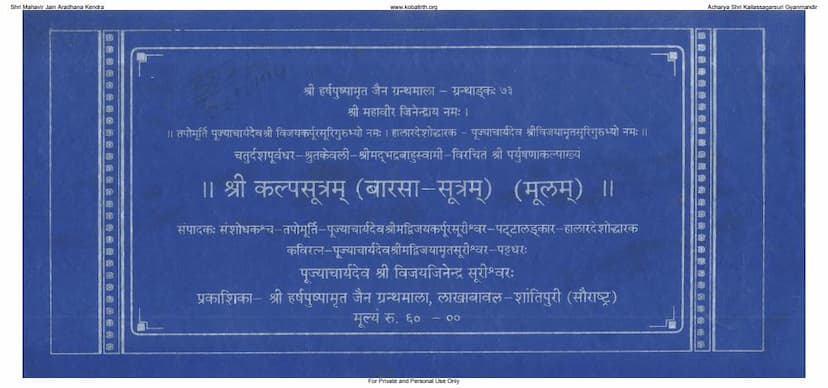Kalpasutra
Added to library: September 2, 2025

Summary
Here's a comprehensive summary of the provided Jain text, the Kalpasutra, based on the pages you've supplied:
Book Title: Kalpasutra (also referred to as Paryushana Kalpa or Barasa-Sutra) Author: Jinendrasuri (Bhadrabahuswami) Publisher: Harshpushpamrut Jain Granthmala Catalog Link: https://jainqq.org/explore/020430/1
Overall Summary:
The Kalpasutra, authored by the esteemed Chaturdasha-purvadhar and Shruta-kevali Shri Bhadrabahuswami, is a foundational text in Jainism, particularly important for the Shvetambara tradition. It is primarily focused on the observance of Paryushana, the most important annual festival of fasting and penance in Jainism. The provided pages offer a glimpse into the detailed narration of the life and events surrounding Lord Mahavir Swami, the 24th Tirthankara, and also touch upon the lives and genealogies of other Tirthankaras like Parshvanath, Neminath, and Rishabhanatha. The text is rich in descriptions of celestial events, divine interventions, and the strict codes of conduct for Jain ascetics.
Key Themes and Content from the Provided Pages:
- Genealogy and Conception of Tirthankaras: A significant portion of the text is dedicated to the auspicious conception and birth of Lord Mahavir Swami. It details his descent from the celestial realms (specifically the Mahavijaya Mahavimana) into the womb of Queen Trishala (Devananda initially). The text emphasizes the purity and divine nature of these births, often preceded by specific celestial events and auspicious dreams.
- Devananda's Dreams (Sutras 3-6, 12): The pages detail the fourteen auspicious dreams that Devananda, Mahavir's maternal mother (though the text later clarifies Mahavir's birth in the Kshatriya lineage, this section might reflect a specific narrative strand or a preceding conception), experienced. These dreams are interpreted as omens of a great soul's birth and include visions of an elephant, bull, lion, Abhishek (consecration), garland, moon, sun, flag, lotus pond, ocean, mansion, jewel heap, and fire.
- Trishala's Dreams (Sutras 31-46): Similarly, the text describes the fourteen auspicious dreams experienced by Queen Trishala, Mahavir's mother. These are described in great detail, painting vivid imagery of divine symbols like an elephant, bull, lion, celestial throne, moon, sun, etc., signifying the greatness of the child to be born.
- Divine Intervention (Sutras 20-28): The text highlights the role of Indra (Shakra Devaraja) and the celestial being Harinegameshi in transferring the divine embryo from Devananda to Trishala to ensure Mahavir's birth in a Kshatriya lineage, as destined for a Tirthankara. This divine intervention underscores the importance of lineage and purity in the birth of enlightened beings.
- Mahavir's Birth (Sutras 95-98): The auspicious moment of Lord Mahavir's birth is described, including the planetary positions, auspicious times, and celestial celebrations.
- Interpretation of Dreams: The text emphasizes the importance of interpreting these auspicious dreams, with the king (Siddhartha) and dream interpreters playing a crucial role in predicting the virtuous qualities and future eminence of the child.
- Mahavir's Childhood and Renunciation: While not fully elaborated in these pages, the text sets the stage for Mahavir's life, mentioning his parents (Siddhartha and Trishala), his lineage (Kashyapa Gotra, Ikshvaku dynasty), and the naming ceremony. It also briefly touches upon his vow not to renounce the world while his parents were alive (Sutra 94).
- Lives of Other Tirthankaras: The provided excerpts also include brief accounts of other Tirthankaras, such as Parshvanath, Neminath, and Rishabhanatha, detailing their lives, periods, and the number of disciples and attendants they had. This suggests the Kalpasutra encompasses biographical narratives of various Tirthankaras within its framework.
- The "Staviravali" (Genealogy of Monks/Disciples): A significant section (from page 74 onwards) outlines the lineage of important monks (Theras) and their disciples, tracing the spiritual succession from Lord Mahavir's chief disciples (Ganadharas) like Indrabhuti Gautama and Sudharmaswami, down through various generations. This section is crucial for understanding the continuity and transmission of Jain teachings.
- "Samachari" (Rules of Conduct): The final sections describe the rules and regulations concerning the observance of Varshavas (monsoon retreat), including specific guidelines for monks and nuns regarding their conduct, alms-seeking, food, and purification practices. These rules are detailed and illustrate the rigorous discipline of Jain monastic life.
- Varshavas Observance: The text details the duration and specific practices during the monsoon retreat, emphasizing the need for purity and adherence to strict codes.
- Rules of Conduct: It outlines what is permissible and impermissible for ascetics during this period, such as limitations on entering certain households, consuming specific foods, and carrying or using certain items. The emphasis is on non-violence (ahimsa) and self-control.
Author and Publisher:
The text is attributed to Bhadrabahuswami, a highly revered figure in Jainism, known for his knowledge of the fourteen Purvas (ancient Jain scriptures). The publication is by Harshpushpamrut Jain Granthmala, with the specific edition noted as "Granthanka 73." The editors and correctors are identified as Acharya Shri Vijay Kapoor Surishwar, Acharya Shri Vijayamrut Surishwar, and Acharya Shri Vijay Jinendra Surishwar.
Significance:
The Kalpasutra is central to the Paryushana festival, during which it is recited publicly. It serves as a guide for ascetic practices, understanding the lives of the Tirthankaras, and maintaining the purity of Jain tradition. The detailed descriptions and intricate rules highlight the profound spiritual discipline and philosophical depth of Jainism.